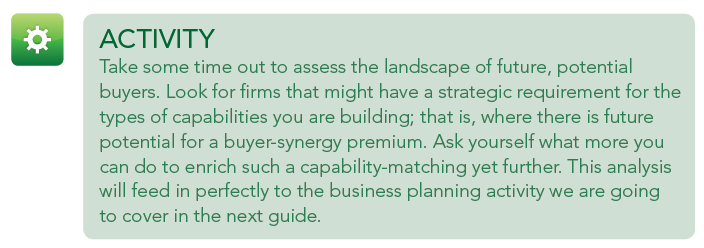Does your company have value (and values)?

Photo Credit: NikkiDiBiasio via Compfight cc
Additional Value Considerations
In previous blog postings, we have looked now at all the elements of a company’s value that you, as a directing owner, have real influence over. In summary, you increase your firm’s value by growing profit and by embedding the ‘multiple enhancing’ capabilities (which make such profit growth sustainable).
There are, however, other factors that will influence any valuation – market premium and buyer synergy.
By market premium, I am referring to the general state of the market. In a bullish phase of the economy, companies will trade with a premium on average multiples (sellers’ market). Conversely, in a recessionary period, with less merger and acquisition activity, multiples will be depressed against a historical average. The key point here is to do with the timing of your value realisation point. You should, clearly, take a perspective on the likely economic cycle you are in before you set any ‘value realisation’ time schedule.
By buyer synergy, I am referring to the situation of a trade sale when a buyer is attracted to a particular aspect of your company (services, geographic reach, client base, resource skill set) which, when added to their model, unleashes an exciting, new profit-yielding capability. Think ‘1 + 1 = 3’ logic. The more idiosyncratic/rare this matching is, the higher a synergy premium you can command. If the combination really works for the buyer, if it really talks to a strategic growth ambition they have, then the synergy value can be so high as to dwarf all the other sources of premium value I have mentioned.
At first flush, it may appear that you have minimum control over these latter two aspects but this is not so. Getting the right market premium is about having a dynamic, strategic timetable and constantly monitoring the macro/economic conditions to select your future, ‘sweet spot’ moment. Similarly, you can improve the chances of a premium buyer-synergy sale by undertaking a thorough buyer search-and-tell exercise at the start of any competitive sale process. I will cover this in Guide 20.
Finally, a key factor you should also consider now is what you intend to do at such a future point. If you are still very much a driving force behind the company at a point of sale, you will not be able to just walk off into the sunset. To do so, would have serious implications for the valuation; indeed, it would likely negate any chance of finding an interested buyer. The usual situation is, rather, that key leadership members will be locked-in for a (typically one-to-three year) period (through the incentive of an ‘earn-out’ arrangement). The only way you, as an active owner now, can plan for departure-on-exit without any erosion of value is to essentially design yourself out of all the management processes in the interim. For any buyer to believe your complete departure will not denude value they will need to be sure you have had minimal influence on the immediately previous trading history, or company operation. That is, you have effectively already retired to shareholder-only status some time prior to the sale. Whilst such an effective pre-sale extraction certainly makes the growth journey even more challenging, it is not impossible; but, clearly, if that is your ambition, it will require very, very careful management.
‘The Other Values’
The word ‘value’ tends to get overdone to the point of hackneyed exhaustion in business literature. I may be guilty of it myself in this set of articles. When taken, however, in the context of an event when an external buyer and yourself are negotiating terms for the sale of your business – value is a very real object indeed. Such a moment may well be the most significant wealth-creation moment of your career; one that buys you many personal freedoms beyond, so it is critical now – ideally pre-departure – that we do labour this understanding together.
I have written a whole Guide on this topic because I want you to be fixated on where value truly lies before you even begin the process of building it in to your company. If it causes you to invest in activities that go to the heart of this – and to avoid the ego-traps and the irrelevant, then it will have achieved its aim. The remainder of the series will focus on how you actually go about building value such that you eventually get to a place where you have, at least, the option of accessing it.
Before I close this set of blog postings though, I can’t skip over the alternative definition of ‘a value’; that is the human/ethical values that sit behind, and determine, your firm’s culture. As you will have noted in the ‘Multiple Enhancers’ blog, a high-performing team is essential for a premium valuation. When all is said and done – and these pretty diagrams and formulas are analysed – it all comes down to a point that is not even captured within them. No buyer is going to place any value on a loose group of rotating associates who just muster for the client pay cheque; rather, they will be looking for real delivery team cohesion, collaboration and a collective loyalty to the firm and its clients. It is, further to this, impossible to build all the other multiple-enhancing capabilities I describe without such a team ethic in situ in the first place. Getting this buy-in, this extraordinary psychological contract from your colleagues, only comes about if you build a values-based culture from the off. I will leave this point there for now; it deserves necessary expansion in its own guide (Guide 09); suffice to say, in final analysis, the real path to building value starts with having values.
In the next set of blog postings, I will turn to the essential topic of business planning.
——————


